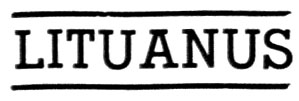
Managing Editor P. V. Vygantas
 |
www.lituanus.org |
|
Copyright
© 1957 Lithuanian
Students Association, Inc.
March,
1957 No.2(10)
Managing Editor P. V. Vygantas |
|
CAPSULE REVIEWS:
Raštikis, Stasys; Kovose Del Lietuvos, Kario Atsiminimai (In the Battles for Lithuania, Memoirs of a Soldier) Vol 1. Published by Lithuanian Days, Los Angeles, 1956; 704 p., Price $7.
These
memoirs, by the former commander-in-chief of the Lithuanian army, cover
the period from the First World War to the first Russian invasion of
World War n. Extensive and personal, they depict the political and
military life of Lithuania's independence. A second volume is slated to
follow.
***
Baranauskas, Albinas; Sniego Platumos (The Fields of Snow). Published by Nida Press, London, Copyright 1955, 273 p.
A
young Lithuanian author makes his literary debut with this collection
of short stories. With a frequent touch of humor, he recreates simple
episodes from the town of Virbaliai and the surrounding farms. The
stories are mainly impressionistic evocations, loosely connected by the
device of a story-teller.
***
Pukelevičiūtė, Birute; Aštuoni Lapai (Eight Leaves) published by The Lithuanian Book Club, Chicago 1956.
A
notable addition to the substantial body of Lithuanian novels using
World War II themes. This autobiographical novel by a young Lithuanian
writer was winner of the 1956 "Draugas" prize for literature. It
describes the experiences of a ycung woman in Germany, during the final
days of the war. The story is told in a series of pictures alternating
between her life in Lithuania and in Germany, contrasting the idyll
with the nightmare.
***
Mazalaitė, Nelė; Pjūties Metas (Harvest Time). Published by the Lithuanian Book Club, Chicago 1956; 387 p. Price $3.75.
The latest work of a well known Lithuanian woman novelist. It is an atempt at psychological insight and is concerned with human problems rather than events. It takes place in Lithuania, during the last war and is a study of a person from a Catholic and patriotic family, who through misguided ideal sm, begins collaborating with the Communist regime.
***
Yla, Stasys; Laisves Problema (The Problem of Freedom). Published by Immaculata Press, Putnam, Conn. 1956; 246 p.
A
Lithuanian priest attempts to penetrate into the problem of human
freedom. The bulk of the book is taken by critical evaluation of the
different opinions on freedom in Western philosophy.
***
Gruodis, Eugenijus; Aguonos ir Smėlis (Poppies and Sand, Poems) Published by the Lithuanian Book Club, Chicago, 1956; 70 p., Price $1.
The
first published work of the young author is a book of short free verse
poems. He alternates between the cosmic and the minute, achieving
especially interesting results in his allegoric miniatures.
***
Gustaitis, Antanas; Anapus Teisybės (Beyond Truth, Humoristic Verse). Published by Gabija; 144 p., Price $2.20.
A
bock of quality satyric verse a rarely cultivated genre in Lithuanian
literature. The author's thrusts are mainly directed at the efforts of
the newly arrived immigrants toward bettering their social and
financial position.
***
Comprehensive study by Dr. M. Gimbutas, entitled Ancient Symbolism In Lithuanian Folk Art
will be published by the University of Indiana, home of the world
famous Institute of Folklore. The publication will have 102 pages of
text and 160 pages of illustrations of Lithuanian folk art as well as
prehistorical a-t.
Those interested in obtaining the publication
mentioned should address their orders to Dr. M. Gimbutas, 4 Rutledge
St., Boston 32, Ma"s. A check or money order of $2.50 should be
enc!osed.